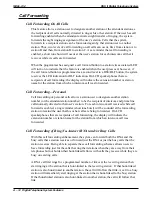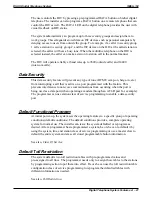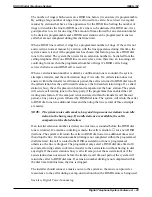
dropped by the caller. The caller continues to receive ringback tone until the call is
answered. The overflow station can service the call or transfer it back to the department
using the department pilot number. When the call is transferred back to the department
by an overflow station, it will not return to the overflow station until that station is idle
and has no ringing calls either new or transferred. Instead, the call will camp-on at the
department and wait for a station to become idle. The caller will receive music while on
hold if the system is so equipped. To provide reassurance to the caller during ringing it is
recommended that a music source be connected to the system. The call will remain in a
held state until it is answered or until the department transfer recall timeout period has
ended.
When the recall timeout period has ended, the call will return to the transferring station.
Intercom calls that are made to the department will test the department stations for busy
or a RNA. If all stations are busy, a busy tone is returned to the caller. Intercom calls will
not camp-on at the department but will go to the overflow station. Further, the system
camp-on feature cannot be used to camp-on to a department.
Subsequent calls to a department on a particular line always try the next station in the
department from whichever station serviced the last call on that line.
To understand this, assume a department with stations 15, 16, and 12 assigned as
department members 1, 2, and 3. Further assume lines 1, 2, and 3 are programmed to ring
in this department. To create a randomizing effect, the system tracks for each line which
department member (1, 2, or 3) serviced it last. When the next call arrives on line 1, for
instance, the system makes a search for the next idle department member after the last
one that serviced a call on line 1. Since there are several lines assigned to the department
and conversation times and wrap-up times vary, a natural random distribution of calls on
lines 1, 2, and 3 at stations 15, 16, and 12 will occur. Further, since the system is keeping
track on a per line basis of the servicing stations as department members instead of
station numbers, the programmer could rearrange the department list without having any
effect on call distribution. As the programmer adds more stations to a department, the
randomizing effect improves.
Since the RNA time of a station is a programmable feature, department stations can be
set to have a short RNA time to allow a call to search rapidly through a department for an
answer.
When an outside or transferred call is ringing at a department station, the station user can
press the pre-programmed Do Not Disturb (DND) button to place the station in an
off-duty condition. While off-duty, all outside and transferred calls skip to the next
department station. This off-duty condition remains set until the DND button is pressed
again to place the station back in service. When the overflow station is set to DND, all
incoming and transferred calls will return to the department queue.
IMI66–132
DSU II Digital Telephone System
A – 26 Digital Telephone System Features
Summary of Contents for DSU II
Page 31: ......
















































